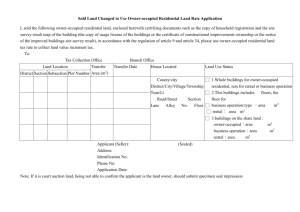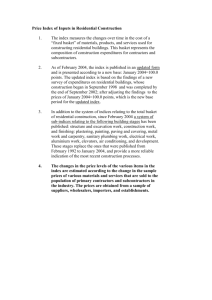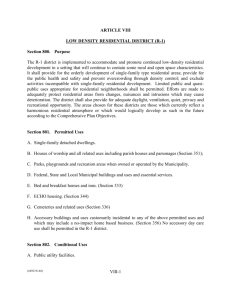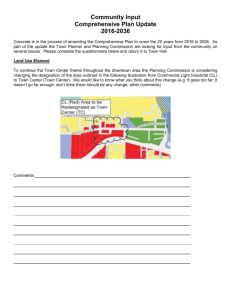Site Plan Review draft bylaw
advertisement
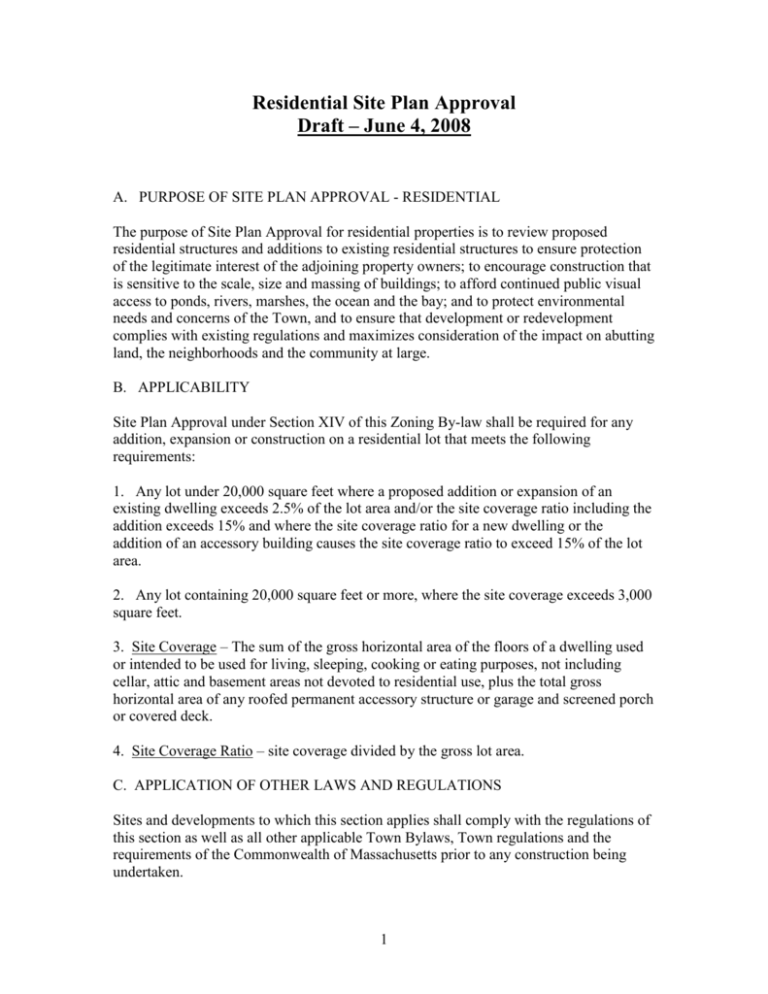
Residential Site Plan Approval Draft – June 4, 2008 A. PURPOSE OF SITE PLAN APPROVAL - RESIDENTIAL The purpose of Site Plan Approval for residential properties is to review proposed residential structures and additions to existing residential structures to ensure protection of the legitimate interest of the adjoining property owners; to encourage construction that is sensitive to the scale, size and massing of buildings; to afford continued public visual access to ponds, rivers, marshes, the ocean and the bay; and to protect environmental needs and concerns of the Town, and to ensure that development or redevelopment complies with existing regulations and maximizes consideration of the impact on abutting land, the neighborhoods and the community at large. B. APPLICABILITY Site Plan Approval under Section XIV of this Zoning By-law shall be required for any addition, expansion or construction on a residential lot that meets the following requirements: 1. Any lot under 20,000 square feet where a proposed addition or expansion of an existing dwelling exceeds 2.5% of the lot area and/or the site coverage ratio including the addition exceeds 15% and where the site coverage ratio for a new dwelling or the addition of an accessory building causes the site coverage ratio to exceed 15% of the lot area. 2. Any lot containing 20,000 square feet or more, where the site coverage exceeds 3,000 square feet. 3. Site Coverage – The sum of the gross horizontal area of the floors of a dwelling used or intended to be used for living, sleeping, cooking or eating purposes, not including cellar, attic and basement areas not devoted to residential use, plus the total gross horizontal area of any roofed permanent accessory structure or garage and screened porch or covered deck. 4. Site Coverage Ratio – site coverage divided by the gross lot area. C. APPLICATION OF OTHER LAWS AND REGULATIONS Sites and developments to which this section applies shall comply with the regulations of this section as well as all other applicable Town Bylaws, Town regulations and the requirements of the Commonwealth of Massachusetts prior to any construction being undertaken. 1 D. REVIEW STANDARDS AND CRITERIA The concurring vote of a majority of the members of a duly constituted quorum of the Planning Board may approve a site plan in the form submitted or with such reasonable conditions, unless it finds that (a) the application for site plan approval is incomplete, (b) the imposition of reasonable conditions will not ensure that the project will conform to the standards and criteria described herein (c) the project does not comply with the requirements of the Zoning By-law. The standards and criteria are as follows: 1. The landscape shall be preserved in its natural state insofar as practical. The Board shall encourage the applicant to avoid grade changes and the removal of native vegetation and soil. Landscaping shall consist primarily of native plants and trees. Any grading or earth-moving shall be planned and executed in such a manner that final contours are consistent with existing terrain both on and adjacent to the site. 2. The proposed development shall relate to the terrain and to the use, scale and proportions of existing and proposed buildings in the neighborhood. The development shall be integrated into the existing terrain and surrounding landscape, and protect abutting properties and community amenities. Placement of buildings and structures shall not degrade the site’s scenic qualities and shall compliment the natural landscape. Foundations shall be constructed to reflect the natural slope of the terrain. 3. Proposed development shall be consistent with the prevailing character, height and scale of other buildings in the neighborhood and the Town. The development should be of appropriate size and massing with breaks in roof and wall lines and with variation in detail, form and siting. The design of proposed buildings and additions shall complement, whenever feasible, the general setback, roofline, arrangement of openings, color, exterior materials, proportion and scale of existing buildings in the vicinity. Buildings on a slope pose unique design and development challenges since "mass and scale" when viewed from the uphill side may seem starkly different from "mass and scale" when viewed from the downhill side. To mitigate such stark differences, variations in scale and mass and the creative use of interconnected building elements are encouraged so that "scale and mass" when viewed from the downhill side is nearly as harmonious to the surroundings as when viewed from the uphill side. 4. Proposed building sites shall avoid impact on steep slopes, flood plains, hilltops, dunes, scenic views and wetlands to preserve the integrity and scenic qualities of natural features. 5. Development and redevelopment on or within one hundred (100) feet landward of a coastal bank or dune shall be designed to have no adverse effect on the height, stability, or the use of the bank or dune as a natural sediment source. In areas where banks or dunes are eroding, the setback for all new building and septic systems to the top of the coastal bank or dune crest shall be at least thirty (30) times the average annual erosion 2 rate of the bank or dune. This rate shall be determined by averaging the erosion over the previous thirty (30) year period. 6. Proposed developments shall preserve and protect unique natural and/or historical features. Development and redevelopment along the coastline shall not interfere with existing public access and traditional public right-of-way to and environmentally appropriate use of the shoreline. Minimize obstruction of water views and other scenic views from publicly accessible locations. Electric, telephone, cable and other utility lines shall be installed underground unless specifically waived. 7. The protection of unique or significant environmental resources including protection and maintenance of groundwater quality and recharge volume and the water quality of coastal and fresh surface water bodies is critical. All runoff shall be recharged on site based on a calculated 25-year storm and storm water infiltration systems shall be designed so that run-off shall not be increased, groundwater recharge is maximized, pollution impacts are minimized and neighboring properties will not be adversely affected 8. A minimum of 20 foot wide vegetated buffer shall be provided along the inside property line perimeter of the lot under consideration, unless otherwise agreed to by the Planning Board. Said vegetated buffer should consist primarily of undisturbed, existing vegetation unless, in the opinion of the Planning Board, the existing vegetation is insufficient to serve the purpose, in which case, the Planning Board may require installation of fencing, berms, and/or additional vegetation to provide an adequate buffer. Proposed plans should screen objectionable features such as retaining walls, excessive support members or mechanical systems from neighboring properties and roadways. 9. Lighting must be consistent with General Bylaws of the Town of Wellfleet. There shall be protection of adjacent properties and the night sky from intrusive lighting. Consideration should be given to the placement of decks and patios and their potential for noise pollution and its adverse impact on adjacent properties. 10. Entrances, ramps, walkways, drives and parking, the location and number of access points, the public street (especially in relation to existing traffic control and mass transit facilities), width of interior drives and access points, general interior circulation, pedestrian and vehicular traffic shall be safe and convenient and, insofar as practicable, not detract from the use and enjoyment of proposed and adjacent buildings and structures, and not materially reduce the level of service on any public ways. E. PRELIMINARY DISCUSSION/REVIEW Prior to filing applications for permits for a residential development subject this by-law, the applicant is encouraged, although not required to meet with the Planning Board for a preliminary discussion/review. 3 F. SITE ALTERATION 1. No building permit, site clearing, filling, grading, material deliveries or construction shall be initiated on any site to which this section applies until any required Residential Site Plan endorsement is obtained from the Planning Board. 2. Nothing herein shall be construed to prohibit such site clearing or altering as may be necessary to conduct pre-development studies such as geotechnical tests, soil borings, wetlands determination, percolation tests for septic systems as required by the Board of Health, or other similar tests required by any law or regulation of standing. G. REQUIRED SUBMISSIONS All site plans submitted under this section: 1. All site plans shall be prepared by a Registered Professional Land Surveyor and Registered Professional Civil Engineer. 2. All site plans shall be on standard 24" x 36" sheets, and each sheet shall be prepared at an appropriate scale suitable for the content of the topic covered on the sheet and shall include the following: a. The location and boundaries of the lot including monuments, adjacent street/ways and a list showing names and addresses of direct abutters and abutters to the abutters within 300 feet, b. Existing and proposed topography showing 2 foot contours showing “benchmark used and significant land features, natural and man made, including, but not limited to, the location of significant trees or vegetation, wetlands, streams, bodies of water, drainage swales and areas subject to flooding. c. Existing and proposed structures, including dimensions and all elevations, d. The existing and proposed location of driveways, walkways, access and egress points, and the location and number of parking spaces. e. The location and description of all proposed on site wells, water supply systems, storm drainage systems, utilities and location and capacity of septic systems. f. Proposed landscape plan showing the location and description of screening fencing, plantings, significant trees and finished grade contours. 3. Include approvals from other regulatory boards and commissions required, including but not limited to the Board of Health, The Conservation Commission, the Historic 4 Review Commission, but with the exception of a Special Permit from the Zoning Board of Appeals, if anticipated, or other permits which legally must succeed the Site Plan Approval by the Planning Board. The Planning Board shall have the right upon good cause to waive all or any part of the above site plan content requirements, such waiver to occur within a public hearing. H. APPLICATION PROCEDURE & FEES Each application for Site Plan approval - residential shall be filed with the Planning Board along with ten (10) copies and the required fee. The Planning Board shall have the authority to require that the applicant pay for necessary professional services reasonably required to review and to analyze adequately the contents of any site plan or related impact study requested by the Board. I. PUBLIC HEARING Upon receipt of the application by the Wellfleet Town Clerk, the Planning Board shall hold an advertised public hearing within 60 days. Said advertisement shall appear in a local newspaper of general publication no less than 14 days prior to the scheduled public hearing. It shall be the responsibility of the Planning Board to notify abutters via certified return receipt mail, with said mailing to take place no less than 14 days prior to the scheduled public hearing. J. PLANNING BOARD DECISION The Planning Board shall render a written decision within sixty (60) days of the close of the public hearing, and shall file its written decision with the Town Clerk's office and shall send out a copy of said decision to the applicant, the owner, the representative and the abutters. K. RECORDING OF DECISION The applicant shall be responsible for filing the Planning Board decision at the Barnstable Registry of Deeds or Land Court, as applicable. Prior to the issuance of a building permit, the applicant shall present evidence of such recording to the Building Commissioner and the Planning Board Secretary. L. EFFECT A Residential Site Plan approved by the Planning Board becomes the official development plan for a site within the Town of Wellfleet. The endorsed Residential Site Plan is legally binding upon the holder and any future owner(s). 5 M. SPECIAL PERMITS For those projects which require a Special Permit(s) from the Board of Appeals, the Planning Board shall forward its findings and recommendations to the Board of Appeals. N. EXPIRATION Site Plan endorsement shall expire two (2) years from the date of endorsement unless substantial construction has occurred. Substantial construction will be determined by a majority vote of the Planning Board. At the discretion of the Board, a time extension for project completion may be granted. 6

